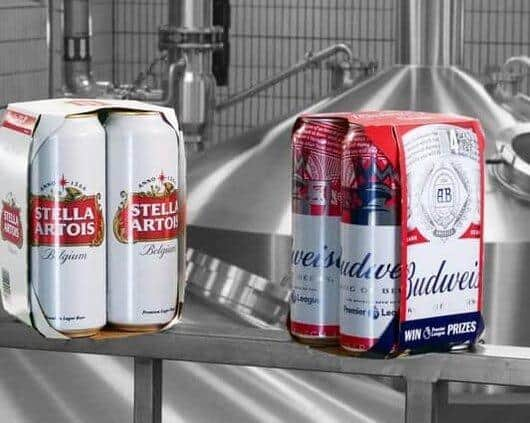Samlesbury brewery's hydrogen power plan backed by councillors - but one warns of potential gas pipe 'catastrophe'
and live on Freeview channel 276
The development - subject to there being no objection from the government - will be constructed on greenbelt land next to the InBev brewery in Samlesbury, where brands including Budweiser, Stella Artois and Corona are produced.
South Ribble Borough Council’s planning committee approved the decarbonisation proposal, but one member said he was “flabbergasted” that his colleagues did not share the safety concerns he had over a gas pipeline that runs through the site.
Advertisement
Hide AdAdvertisement
Hide AdCllr Peter Mollineaux, who also represents the Samlesbury and Warton ward in which the hydrogen plant will be built, said: “If…there was an explosion, it'd be catastrophic.”


Locals also questioned the extent to which the technology underpinning the plans was proven, but the firm behind the plans insisted that it was both safe and would bring huge benefits to the borough.
The applicant, Samlesbury Net Zero Ltd., will build and operate the hydrogen facility independently of the brewery, but the drinks producer will be sole user of the power created at the Cuerdale Lane site. Its vehicles will also, in future, be fuelled by the hydrogen produced there.
The process to be undertaken - known as electrolysis - works by using electricity to split water into its constituent parts, hydrogen and oxygen. The hydrogen gas is then captured, while the oxygen is released into the atmosphere. It will enable InBev to operate its boilers using hydrogen instead of natural gas.
Advertisement
Hide AdAdvertisement
Hide AdDominic Page, the agent for the application, told the committee that a test site operated by the firm in Wales - using “similar technology” to that proposed for Samlesbury - had “demonstrated that hydrogen can be captured safely and efficiently for commercial use”. He said that it had also been operated “by numerous companies internationally and is therefore tried and tested”.
“The proposal will be a market-leading, carbon-free energy development - the first of its kind in South Ribble.
“Significant benefits will be gained by local nature reserves, designated wildlife sites, local residents and the local highway network as a result of improved air quality directly from oxygen emitted by the proposed plant and the removal of up to 11,000 tonnes of carbon emissions from the brewery every year,” Mr. Page added.
However, local resident John Greaves - an electrochemist by trade - claimed that the way in which the plans had been presented at a public consultation event was “a load of rubbish”. He said that the process proposed for Samlesbury was “only a prototype”.
Advertisement
Hide AdAdvertisement
Hide AdIn written objections, other residents had raised a raft of environmental, highway and hydrogen-related concerns.
Cllr Jasmine Gleave - the second ward member for Samlesbury and Walton - also questioned the “green credentials” claimed within the application, adding: “Even renewable energy projects located in the greenbelt must demonstrate very special circumstances [in order to be approved] - and I don't believe these have been demonstrated here. I don’t see any benefit [from the project] outweighing [the] harm to the greenbelt.”
However, for her fellow ward councillor, safety was the number one concern.
“[Given] this pipeline that runs across [the site], it just seems a bit weird to me that everybody seems to be saying, ‘Oh, it's fine, it won't be a problem,'" Cllr Mullineaux said.
“I just can’t accept that this is safe.”
Advertisement
Hide AdAdvertisement
Hide AdPlanning officer Debbie Roberts told the committee that separate permits relating to safety would have to be obtained by the applicant and stressed that Health and Safety Executive, Lancashire Police’s counter-terrorism unit and Cadent - the company responsible for the gas pipeline - had not objected to the plans.
In a late submission to a consultation into the proposal, Cadent sought - and was granted - a a condition on the planning permission which means that a detailed plan for the hydrogen works must be agreed before they can begin, including their exact position.
The gas distribution firm may also demand and monitor any modifications needed in order to secure its apparatus “against interference or risk of damage” and in order to allow access to be maintained.
Addressing the committee, South Ribble’s lead member for climate change, Keith Martin, heralded what he said was “a fantastic opportunity to reduce the carbon footprint” of the brewery and the borough, which declared a climate emergency in 2019.
Advertisement
Hide AdAdvertisement
Hide AdHe suggested creating a “stakeholders' forum” for councillors and residents “to ensure that their safety is assured and their input is valued and taken into account”.
Committee member Haydn Williams said of the hydrogen development: “Somebody somewhere is going to have to be the first to do it and I think we should be the first to do it.”
A proposal by Cllr Mullineaux to refuse the application was defeated by eight votes to two and the blueprint was then approved by the same margin.
However, national planning regulations mean that when a local authority resolves to approve an application for major development that would have “a significant impact on the openness of the greenbelt” – either because of its scale, nature or location – the Secretary of State must be notified, triggering a 21-day period during which the government can decide whether it wants to ‘call in’ the council’s decision for further consideration.